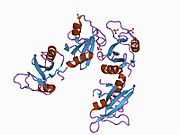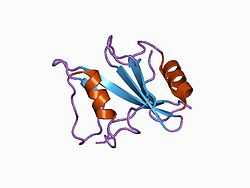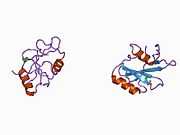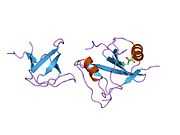SH2D1A
| SH2 domain containing 1A | |||||||||||||
|---|---|---|---|---|---|---|---|---|---|---|---|---|---|
 PDB rendering based on 1d1z. | |||||||||||||
| |||||||||||||
| Identifiers | |||||||||||||
| Symbols | SH2D1A ; DSHP; EBVS; IMD5; LYP; MTCP1; SAP; SAP/SH2D1A; XLP; XLPD; XLPD1 | ||||||||||||
| External IDs | OMIM: 300490 MGI: 1328352 HomoloGene: 1762 GeneCards: SH2D1A Gene | ||||||||||||
| |||||||||||||
| RNA expression pattern | |||||||||||||
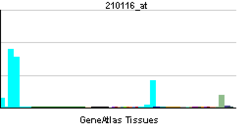 | |||||||||||||
 | |||||||||||||
 | |||||||||||||
| More reference expression data | |||||||||||||
| Orthologs | |||||||||||||
| Species | Human | Mouse | |||||||||||
| Entrez | 4068 | 20400 | |||||||||||
| Ensembl | ENSG00000183918 | ENSMUSG00000005696 | |||||||||||
| UniProt | O60880 | O88890 | |||||||||||
| RefSeq (mRNA) | NM_001114937 | NM_011364 | |||||||||||
| RefSeq (protein) | NP_001108409 | NP_035494 | |||||||||||
| Location (UCSC) | Chr X: 123.48 – 123.51 Mb | Chr X: 42.5 – 42.52 Mb | |||||||||||
| PubMed search | |||||||||||||
SH2 domain-containing protein 1A is a protein that in humans is encoded by the SH2D1A gene.[1][2][3]
It is associated with X-linked lymphoproliferative disease.
Interactions
SH2D1A has been shown to interact with FYN,[4][5] SLAMF1,[6][7] CD84,[8][9][10][7] LY9[7][9] and DOK1.[11]
References
- ↑ Coffey AJ, Brooksbank RA, Brandau O, Oohashi T, Howell GR, Bye JM, Cahn AP, Durham J, Heath P, Wray P, Pavitt R, Wilkinson J, Leversha M, Huckle E, Shaw-Smith CJ, Dunham A, Rhodes S, Schuster V, Porta G, Yin L, Serafini P, Sylla B, Zollo M, Franco B, Bolino A, Seri M, Lanyi A, Davis JR, Webster D, Harris A, Lenoir G, de St Basile G, Jones A, Behloradsky BH, Achatz H, Murken J, Fassler R, Sumegi J, Romeo G, Vaudin M, Ross MT, Meindl A, Bentley DR (October 1998). "Host response to EBV infection in X-linked lymphoproliferative disease results from mutations in an SH2-domain encoding gene". Nat Genet 20 (2): 129–135. doi:10.1038/2424. PMID 9771704.
- ↑ Sayos J, Wu C, Morra M, Wang N, Zhang X, Allen D, van Schaik S, Notarangelo L, Geha R, Roncarolo MG, Oettgen H, De Vries JE, Aversa G, Terhorst C (November 1998). "The X-linked lymphoproliferative-disease gene product SAP regulates signals induced through the co-receptor SLAM". Nature 395 (6701): 462–469. doi:10.1038/26683. PMID 9774102.
- ↑ "Entrez Gene: SH2D1A SH2 domain protein 1A, Duncan's disease (lymphoproliferative syndrome)".
- ↑ Li, Chengjun; Iosef Cristiana; Jia Christina Y H; Han Victor K M; Li Shawn Shun-Cheng (February 2003). "Dual functional roles for the X-linked lymphoproliferative syndrome gene product SAP/SH2D1A in signaling through the signaling lymphocyte activation molecule (SLAM) family of immune receptors". J. Biol. Chem. (United States) 278 (6): 3852–3859. doi:10.1074/jbc.M206649200. ISSN 0021-9258. PMID 12458214.
- ↑ Chan, Betty; Lanyi Arpad, Song Hyun Kyu, Griesbach Jan, Simarro-Grande Maria, Poy Florence, Howie Duncan, Sumegi Janos, Terhorst Cox, Eck Michael J (February 2003). "SAP couples Fyn to SLAM immune receptors". Nat. Cell Biol. (England) 5 (2): 155–160. doi:10.1038/ncb920. ISSN 1465-7392. PMID 12545174.
- ↑ Howie, Duncan; Simarro María; Sayos Joan; Guirado Maria; Sancho Jaime; Terhorst Cox (February 2002). "Molecular dissection of the signaling and costimulatory functions of CD150 (SLAM): CD150/SAP binding and CD150-mediated costimulation". Blood (United States) 99 (3): 957–965. doi:10.1182/blood.V99.3.957. ISSN 0006-4971. PMID 11806999.
- ↑ 7.0 7.1 7.2 Morra, M; Simarro-Grande M, Martin M, Chen A S, Lanyi A, Silander O, Calpe S, Davis J, Pawson T, Eck M J, Sumegi J, Engel P, Li S C, Terhorst C (September 2001). "Characterization of SH2D1A missense mutations identified in X-linked lymphoproliferative disease patients". J. Biol. Chem. (United States) 276 (39): 36809–36816. doi:10.1074/jbc.M101305200. ISSN 0021-9258. PMID 11477068.
- ↑ Tangye, Stuart G; Nichols Kim E, Hare Nathan J, van de Weerdt Barbara C M (September 2003). "Functional requirements for interactions between CD84 and Src homology 2 domain-containing proteins and their contribution to human T cell activation". J. Immunol. (United States) 171 (5): 2485–95. doi:10.4049/jimmunol.171.5.2485. ISSN 0022-1767. PMID 12928397.
- ↑ 9.0 9.1 Sayós, J; Martín M; Chen A; Simarro M; Howie D; Morra M; Engel P; Terhorst C (June 2001). "Cell surface receptors Ly-9 and CD84 recruit the X-linked lymphoproliferative disease gene product SAP". Blood (United States) 97 (12): 3867–3874. doi:10.1182/blood.V97.12.3867. ISSN 0006-4971. PMID 11389028.
- ↑ Tangye, Stuart G; van de Weerdt Barbara C M, Avery Danielle T, Hodgkin Philip D (June 2002). "CD84 is up-regulated on a major population of human memory B cells and recruits the SH2 domain containing proteins SAP and EAT-2". Eur. J. Immunol. (Germany) 32 (6): 1640–9. doi:10.1002/1521-4141(200206)32:6<1640::AID-IMMU1640>3.0.CO;2-S. ISSN 0014-2980. PMID 12115647.
- ↑ Sylla, B S; Murphy K; Cahir-McFarland E; Lane W S; Mosialos G; Kieff E (June 2000). "The X-linked lymphoproliferative syndrome gene product SH2D1A associates with p62dok (Dok1) and activates NF-kappa B". Proc. Natl. Acad. Sci. U.S.A. (UNITED STATES) 97 (13): 7470–7475. doi:10.1073/pnas.130193097. ISSN 0027-8424. PMC 16569. PMID 10852966.
External links
Further reading
- Sumegi J; Seemayer TA; Huang D et al. (2003). "A spectrum of mutations in SH2D1A that causes X-linked lymphoproliferative disease and other Epstein-Barr virus-associated illnesses". Leuk. Lymphoma 43 (6): 1189–1201. doi:10.1080/10428190290026240. PMID 12152986.
- Engel P, Eck MJ, Terhorst C (2003). "The SAP and SLAM families in immune responses and X-linked lymphoproliferative disease". Nat. Rev. Immunol. 3 (10): 813–821. doi:10.1038/nri1202. PMID 14523387.
- Stern MH; Soulier J; Rosenzwajg M et al. (1993). "MTCP-1: a novel gene on the human chromosome Xq28 translocated to the T cell receptor alpha/delta locus in mature T cell proliferations". Oncogene 8 (9): 2475–83. PMID 8361760.
- Skare J; Wu BL; Madan S et al. (1993). "Characterization of three overlapping deletions causing X-linked lymphoproliferative disease". Genomics 16 (1): 254–255. doi:10.1006/geno.1993.1169. PMID 8387453.
- Nichols KE; Harkin DP; Levitz S et al. (1998). "Inactivating mutations in an SH2 domain-encoding gene in X-linked lymphoproliferative syndrome". Proc. Natl. Acad. Sci. U.S.A. 95 (23): 13765–13770. doi:10.1073/pnas.95.23.13765. PMC 24894. PMID 9811875.
- Poy F; Yaffe MB; Sayos J et al. (1999). "Crystal structures of the XLP protein SAP reveal a class of SH2 domains with extended, phosphotyrosine-independent sequence recognition". Mol. Cell 4 (4): 555–561. doi:10.1016/S1097-2765(00)80206-3. PMID 10549287.
- Li SC; Gish G; Yang D et al. (2000). "Novel mode of ligand binding by the SH2 domain of the human XLP disease gene product SAP/SH2D1A". Curr. Biol. 9 (23): 1355–1362. doi:10.1016/S0960-9822(00)80080-9. PMID 10607564.
- Sylla BS; Murphy K; Cahir-McFarland E et al. (2000). "The X-linked lymphoproliferative syndrome gene product SH2D1A associates with p62dok (Dok1) and activates NF-kappa B". Proc. Natl. Acad. Sci. U.S.A. 97 (13): 7470–7475. doi:10.1073/pnas.130193097. PMC 16569. PMID 10852966.
- Benoit L; Wang X; Pabst HF et al. (2000). "Defective NK cell activation in X-linked lymphoproliferative disease". J. Immunol. 165 (7): 3549–53. doi:10.4049/jimmunol.165.7.3549. PMID 11034354.
- Nagy N; Cerboni C; Mattsson K et al. (2000). "SH2D1A and SLAM protein expression in human lymphocytes and derived cell lines". Int. J. Cancer 88 (3): 439–447. doi:10.1002/1097-0215(20001101)88:3<439::AID-IJC17>3.0.CO;2-#. PMID 11054674.
- Shlapatska LM; Mikhalap SV; Berdova AG et al. (2001). "CD150 association with either the SH2-containing inositol phosphatase or the SH2-containing protein tyrosine phosphatase is regulated by the adaptor protein SH2D1A". J. Immunol. 166 (9): 5480–7. doi:10.4049/jimmunol.166.9.5480. PMID 11313386.
- Sayós J; Martín M; Chen A et al. (2001). "Cell surface receptors Ly-9 and CD84 recruit the X-linked lymphoproliferative disease gene product SAP". Blood 97 (12): 3867–3874. doi:10.1182/blood.V97.12.3867. PMID 11389028.
- Morra M; Simarro-Grande M; Martin M et al. (2001). "Characterization of SH2D1A missense mutations identified in X-linked lymphoproliferative disease patients". J. Biol. Chem. 276 (39): 36809–36816. doi:10.1074/jbc.M101305200. PMID 11477068.
- Latour S; Gish G; Helgason CD et al. (2001). "Regulation of SLAM-mediated signal transduction by SAP, the X-linked lymphoproliferative gene product". Nat. Immunol. 2 (8): 681–690. doi:10.1038/90615. PMID 11477403.
- Bottino C; Falco M; Parolini S et al. (2001). "NTB-A [correction of GNTB-A], a novel SH2D1A-associated surface molecule contributing to the inability of natural killer cells to kill Epstein-Barr virus-infected B cells in X-linked lymphoproliferative disease". J. Exp. Med. 194 (3): 235–246. doi:10.1084/jem.194.3.235. PMC 2193462. PMID 11489943.
- Liu A; Klein G; Bandobashi K et al. (2002). "SH2D1A expression reflects activation of T and NK cells in cord blood lymphocytes infected with EBV and treated with the immunomodulator PSK". Immunol. Lett. 80 (3): 181–188. doi:10.1016/S0165-2478(01)00330-3. PMID 11803050.
- Howie D; Simarro M; Sayos J et al. (2002). "Molecular dissection of the signaling and costimulatory functions of CD150 (SLAM): CD150/SAP binding and CD150-mediated costimulation". Blood 99 (3): 957–965. doi:10.1182/blood.V99.3.957. PMID 11806999.
- Aoukaty A, Tan R (2002). "Association of the X-linked lymphoproliferative disease gene product SAP/SH2D1A with 2B4, a natural killer cell-activating molecule, is dependent on phosphoinositide 3-kinase". J. Biol. Chem. 277 (15): 13331–13337. doi:10.1074/jbc.M112029200. PMID 11815622.
| |||||||||||||||||||
